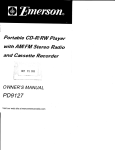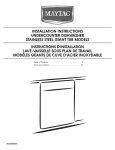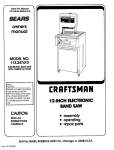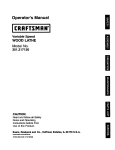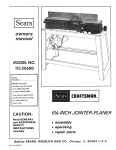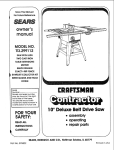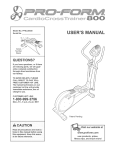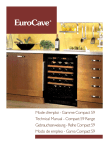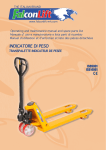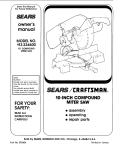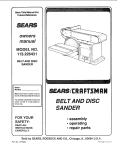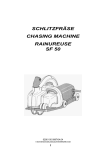Download Craftsman 113.234680 Owner`s manual
Transcript
f
Save This Manual _\
For Future Reference
r
SEARS
owner's
manual
MODEL NO.
113.234680
8¼" COMPOUND
MITER SAW
Serial
Number
Model and serial numbers
may be found at the side of
the miter saw arm.
You should record both
model and serial number in
a safe place for future use.
FOR YOUR
SAFETY:
READ ALL
INSTRUCTIONS
CAREFULLY
SEA/k_S/ I:RRFT$ M g N®
81/4-1NCH COMPOUND
MITER SAW
• assembly
• operating
• repair parts
J
Sold by SEARS, ROEBUCK AND CO., Chicago,
Part No. SP5301
m
rv_ _
IL 60684
,_._14_-I _
U.S.A.
Printed
in Taiwan.
F-
FULL ONE YEAR WARRANTY
ON CRAFTSMAN
MITER SAW
If within one year from the date of purchase, this Craftsman Miter Saw fails due to a defect
in material or workmanship, Sears will repair it, free of charge.
WARRANTY SERVICE IS AVAILABLE BY SIMPLY CONTACTING THE NEAREST SEARS SERVICE CENTER/DEPARTMENT THROUGHOUT THE UNITED STATES.
This warranty applies only while this product is used in the United States.
This warranty gives you specific legal rights, and you may also have other rights which
vary from state to state.
SEARS, ROEBUCK AND CO., D/817 WA Hoffman Estates, IL 60195
SAFETY INSTRUCTIONS
Safety is a combination of common sense, staying alert
and knowing how your miter saw works. Read this manuat to understand this miter saw.
BEFORE
USING
THE
MITER
SAW:
WARNING: To avoid mistakes that could cause
serious, permanent injury, do not plug the miter
saw in until the following steps are completed.
• Assembly and alignment. (See pages 10-14)
• Learn the use and function of the ON-OFF trigger
switch, upper and lower blade guards, handle latch,
bevel clamp, cover plate stop screw, and fence
clamps. (See page 9).
• Review and understand all safety instructions and
operating procedures in this manual.
• Review the maintenance methods for this miter saw.
(See page 22).
Read the following DANGER label found on the motor
of the miter saw:
FOR MITER SAW
WHEN
INSTALLING OR MOVING
THE MITER SAW.
Before moving the saw, lock the miter, bevel and power
head positions. Unplug the power cord.
NEVER carry the saw by the cord or power head handle.
Damage to insulation could cause an electric shock.
Damage to wire connections could cause a fire.
AVOID DANGEROUS ENVIRONMENT. Use the miter
saw in a dry, indoor place protected from rain. Keep
work area well lighted.
Place the miter saw so neither the user or bystanders
are forced to stand in line with the blade. Thrown debris
could injure people in its path.
To avoid injury from unexpected saw movement:
• Put the miter saw on a firm level surface where there
is plenty of room for handling and properly supporting
the workpiece.
• Support the miter saw so the table is level and the
saw does not rock.
Bolt or clamp the saw to its support.
E_]
DOUBLE-INSULATED
When servicing use only
identical replacement parts._
Electrical: 120 volts
('(U| _]
60 Hz AC only, 9 amps
5200 RPM
E85_7_
FOR YOUR OWN SAFETY:
Know this tooliRead
and
Understand the Owner's Manual
before using this tool.
IDANGERI
• Wear safety goggles complying
with ANSI Z87.1
• Tighten arbor screw and all
clamps before sawing.
=Keep guards in place and
working properly.
=Keep hands out of sawblade
path.
• Never cut anything "'free hand."
• Never reach behind or beneath
the sawblade.
• Wait for blade to stop before
moving workpiece, servicing or
adjusting tool.
• To avoid electrical shock do not
expose to rain,
NEVER STAND ON TOOL. Serious injury could
occur if the tool tips or you accidentally hit the cutting
tool. Do not store anything above or near the tool
where anyone might stand on the tool to reach them.
To avoid injury or death from electrical shock:
• THIS TOOL IS DOUBLE INSULATED to give you
added protection. Double insulation does not take
the place of normal safety precautions when operating this tool. When servicing this double insulated
tool, use only identical parts.
• Make sure your fingers do not touch the plug's metal
prongs when plugging or unplugging the miter saw.
BEFORE
EACH USE:
Inspect your miter saw.
DISCONNECT THE MITER SAW. To avoid injury from
accidental starting, unplug the saw, before changing
the setup, changing the blade or adjusting anything.
Compare the direction of rotation arrow on the guard
to the direction arrow on the blade. The blade teeth
should always point downward at the front of the saw.
Tightenthe arborscrew.
Tightenthe coverplatestopscrew.
CHECK DAMAGED PARTS. Check for:
• Alignment of moving parts,
• Damaged electric cords.
• Binding of moving parts.
• Broken parts,
• Stable mounting,
• Function of arm return spring and lower guard: Push
the arm all the way down, then let it rise up until it
stops by itself. Check the lower guard to see if it
closed fully. If it did not, follow the instructions in the
Trouble Shooting section.
• Other conditions that may affect the way the miter
saw works.
KEEP GUARDS IN PLACE, in working order, and in
proper adjustment.
If any part is missing, bent, or broken in any way, or
any electrical parts don't work, turn the saw off and
unplug it. REPLACE damaged, missing, or failed parts
before using the saw again.
MAINTAIN TOOLS WITH CARE. Keep the miter saw
clean for best and safest performance. Follow instructions for lubricating. DON'T put lubricants on the blade
while it's spinning.
REMOVE ADJUSTING KEYS AND WRENCHES from
tool before turning it on.
To avoid injury from jams, slips or thrown pieces:
Plan ahead to protect your eyes,
hands, face, ears.
KNOW YOUR MITER SAW. Read and understand the
owner's manual and labels affixed to the tool. Learn its
application and limitations as well as the specific potential hazards peculiar to this tool.
To avoid injury from accidental contact with moving
parts, don't do layout, assembly, or setup work on the
miter saw while any parts are moving.
AVOID ACCIDENTAL STARTING. Make sure switch is
"OFF" before plugging miter saw into a power outlet.
Plan your work.
USE THE RIGHT TOOL, Don't force tool or attachment to do a job it was not designed to do. Use a
different tool for any workpiece that can't be held in
a solidly braced, fixed position.
CAUTION: This machine is not designed for cutting ferrous metals (steel, iron and iron based
metals). Use this miter saw to cut only wood,
wood like products or soft metals like aluminum.
Other materials may shatter, bind on the blade, or
create other dangers.
!CAUTION: When cutting any metals, sparks or hot
fragments could cause a fire. To avoid this, disconnect any dust collecting hose from the miter
saw, and remove all traces of wood dust from
inside dust traps in the miter saw.
• USE ONLYRECOMMENDEDACCESSORIES.
(See
page 22). Consult this Owner's manual for recommended accessories. Follow the instructions that
come with the accessories. The use of improper accessories may cause risk of injury to persons.
• Choose the right 81/4 inch diameter blade for the
material and the type of cutting you plan to do.
Dress for safety.
I
WEAR
YOUR
GOGGLES
• Make sure the blade is sharp, undamaged and properly aligned. With the saw unplugged, push the
power-head all the way down. Hand spin the blade
and check for clearance. Tilt the power-head to 45
degree bevel and repeat the check. If the blade hits
anything, make the adjustments shown in the Maintaining Maximum Cutting Capacity section.
• Make sure the blade and arbor collars are clean.
• Make sure the arbor collar's recessed sides are facing
the blade.
• Using a 1/2-inch box wrench, make sure the arbor
cap screw is firmly hand tightened,
• Make sure all clamps and locks are tight and no parts
have excessive play.
• KEEP WORK AREA CLEAN. Cluttered areas and
benches invite accidents. Floor must not be slippery.
To avoid burns or other fire damage, never use the miter
saw near flammable liquids, vapors or gases.
Any power miter saw can throw foreign objects into the
eyes. This can cause permanent eye damage. Wear
safety goggles (not glasses) that comply with ANSI
Z87.1 (shown on package). Everyday eyeglasses have
only impact resistant lenses. They are not safety glasses. Safety goggles are available at Sears retail catalog
stores. Glasses or goggles not in compliance with ANSI
Z87.1 could seriously hurt you when they break.
• Do not wear loose clothing, gloves, neckties or
jewelry (rings, wrist watches) They can get caught
and draw you into moving parts.
• Wear nonslip footwear.
• Tie back long hair.
• Roll long sleeves above the elbow.
m
• Noise levels vary widely. To avoid possible hearing
damage, wear ear plugs or muffs when using miter
saw for hours at a time.
• For dusty operations, wear a dust mask along with
the safety goggles.
Inspect your workpiece.
• Make sure there are no nails or foreign objects in
the part of the workpiece to be cut.
WARNING: If planning to cut aluminum or other
non-ferrous metals: Under adverse conditions, the
blade can grab and throw the workpiece suddenly
and unexpectedly. To avoid injury, follow all applicable safety instructions, as you normally would,
and:
•
Use only sawblades specifically recommended
for non-ferrous metal cutting.
Plan your work to avoid THROWBACKS--when
the
workpiece binds on the blade and is torn from your
hands.
•
Do not cut metal workpieces that must be hand
held. Use auxilliary clamps or other equipment
as needed.
Plan the way you will hold the workpiece from start to
finish:
•
Cut non-ferrous metals only if you are experienced or under the supervision of an experienced person.
Avoid awkward operations and hand positions where a
sudden slip could cause fingers or hand to move into
the blade.
DON'TOVERREACH.
Keep good footing and balance.
Keep your face and body to one side, out of line with
a possible throwback.
Never cut FREEHAND:
• Brace your workpiece solidly against the fence and
table top so it will not rock or twist during the cut.
• Make sure there's no debris between the workpiece
and its supports.
• Make sure no gaps between the workpiece, fence
and table will let the workpiece shift after it is cut in
two.
• Never cut more than one workpiece at a time.
• Keep the cut off piece free to move sideways after
it's cut off. Otherwise, it could get wedged against
the blade and thrown violently.
• Cut only one workpiece at a time.
• Clear everything except the workpiece and related
support devices off the table before turning the miter
saw
on.
• SECURE WORK. Use clamps or a vise to help hold
the work when it's practical,
Use extra caution with large, very small or awkward
workpieces:
• Use extra supports (tables, saw horses, blocks, etc.)
for any workpieces large enough to tip when not held
down to the table top.
• NEVER use another person as a substitute for a
table extension, or as additional support for a workpiece that is longer or wider than the basic miter saw
table, or to help feed, support or pull the workpiece.
• Do not use this saw to cut pieces too small to let you
easily hold the work while you keep the thumb side
of your index (pointer) finger against the outside edge
of the fence.
• When cutting irregularly shaped workpieces, plan
your work support so it will not slip, pinch the blade
and be torn from your hands. A piece of molding, for
example, must lie flat or be held by a fixture or jig
that will not let it twist, rock or slip while being cut.
• Properly support round material such as dowel rods,
or tubing. They have a tendency to roll while being
cut, causing the blade to "bite". To avoid this, always
use a fixture designed to properly hold your workpiece.
WHENEVER
SAW IS RUNNING.
WARNING: Don't let familiarity (gained from frequent use of your miter saw) cause a careless
mistake.
A careless
fraction
of a second
is
enough to cause a severe injury.
Before starting your cut, watch the miter saw while it
runs. If it makes an unfamiliar noise or vibrates a lot,
stop immediately. Turn the miter saw off. Unplug the
miter saw. Do not restart until finding and correcting
the problem.
KEEP CHILDREN AWAY. Keep all visitors a safe distance from the miter saw. Make sure bystanders are
clear of the miter saw and workpiece.
Never confine the piece being cut off. Never hold it,
clamp it, touch it, or use length stops against it while
the blade is spinning. It must be free to move sideways
on its own. If confined, it could get wedged against the
blade and thrown violently.
Let the blade reach full speed before cutting.
DON'T FORCE TOOL. It will do the job better and safer
at its designed rate. Feed the blade into the workpiece
only fast enough to let it cut without bogging down or
binding.
Before freeing any jammed material:
• Turn miter saw "OFF" by releasing
trigger switch.
• Unplug the miter saw.
• Wait for all moving parts to stop.
After finishing
a cut:
• Keep holding the power head down,
• Release the switch, and wait for all moving parts to
stop before moving your hands.
• If blade doesn't stop within six 6 seconds, unplug
the saw and follow the instructions in the Trouble
Shooting section for fixing the blade brake before
using the saw again.
BEFORE
LEAVING
THE SAW:
NEVER LEAVE TOOL RUNNING UNATTENDED. Turn
power off. Wait for all moving parts to stop.
Make workshop child-proof. Lock the shop. Disconnect
master switches. Store the tool away from children and
others not qualified to use it.
glossary of terms for woodworking
Arbor
The shaft on which a cutting tool is mounted.
Bevel Cut
An angle cutting operation made through the face of
the work piece.
Resin
A sticky, s_ _ based substance that has hardened.
Revolutions Per Minute (RPM)
The number of turns completed by a spinning object in
one minute.
Compound Cut
A simultaneous bevel and miter cutting operation.
Crosscut
A cutting operation made across the width of the workpiece.
Freehand
Performing a cut without the use of fence (guide), hold
down or other proper device to prevent the workpiece
from twisting during the cutting operation. Twisting of
the workpiece can cause it to be thrown.
Gum
A sticky, sap based residue from wood products.
Heel
Misalignment of the blade.
Kerf
The amount of material removed by the blade in a
through cut or the slot produced by the blade in a nonthrough or partial cut.
Miter Cut
An angle cutting operation made across the width of
the workpiece.
Sawblade Path
The area of the workpiece or table top directly in line
with either the travel of the blade or the part of the
workpiece which will be, or has been, cut by the blade.
Set
The distance that the tip of the sawblade tooth is bent
(or set) outward from the face of the table.
Workpiece
The item on which the cutting operation is being performed. The surfaces of a workpiece are commonly
referred to as faces, ends, and edges.
END
EDGE
electrical connections
POWER
SUPPLY
Motor Specifications
The AC motor used in this saw is a universal, nonreversible type having the following specifications:
Maximum Developed H.R ..................
Voltage .................................
Amperes ..................................
Hertz (Cycles) ............................
Phase ................................
RPM ..................................
Rotation of Shaft ....................
Brake .............................
1V2
120
9
60
Single
5200
Clockwise
Automatic
WARNING: To avoid electrical hazards, fire hazards, or damage to the tool, use proper circuit
protection. Your saw is wired at the factory for
120V operation.
Connect to a 120V, 15-AMP,
branch circuit and use a 15-AMP time delay fuse
or circuit breaker. To avoid shock or fire, if power
cord is worn or cut, or damaged in any way, have
it replaced immediately.
DOUBLE
INSULATED
The miter saw is double insulated to provide a double
thickness of insulation between you and the tool's electrical system. All exposed metal parts are isolated from
the internal metal motor components with protecting
insulation.
Your unit has a plug that looks like the one shown below.
3. If the motor suddenly stalls while cutting wood, release the trigger switch, unplug the tool, and free
the blade from the wood. The motor may now be
restarted and the cut finished.
4. Fuses may "blow" or circuit breakers may trip frequently if:
a. MOTOR IS OVERLOADED--Overloading
can
occur if you feed too rapidly or make too many
start/stops in a short time.
b. Voltages not more than 10% above or below the
nameplate voltage can handle normal loads. For
heavy loads, however, the voltage at motor
terminals must equal the voltage specified on
nameplate.
This power tool is equipped with a 2-conductor cord
listed by Underwriters Laboratories (UL). The plug
permits you to use any conventional 120-volt electrical
outlet without necessity for maintaining a ground
connection.
CAUTION: Double insulation does not take the
place of normal safety precautions when operating this tool.
DANGER: To avoid electrocution:
1. Use only identical replacement parts when servicing a tool with double insulation. Servicing
should be performed by a qualified service
technician.
2. Do not use in rain or where floor is wet.
5. Most motor troubles may be traced to loose or incorrect connections, overload, low voltage (such as
small size wire in the supply circuit) or to overly long
supply circuit wire. Always check the connections,
the load and the supply circuit whenever motor
doesn't work well. Check wire sizes and length with
the Wire Size Chart below.
WIRE SIZES
The use of any extension cord will cause some loss of
power. To keep this to a minimum and to prevent overheating and motor burn-out, use the table below to
determine the minimum wire size (A.W.G.) extension
cord.
For circuits that are farther than 100 feet away from
electrical service box, the wire size must be increased
proportionately in order to deliver ample voltage to the
saw motor.
This tool is intended for indoor residential use
only.
MOTOR
SAFETY
PROTECTION
CAUTION: To avoid motor damage, this motor
should be blown out or vacuumed frequently to
keep sawdust from interfering with normal motor
ventilation.
1. Connect this tool to a 120V, 15-amp branch circuit
with a 15-amp time delay fuse or circuit breaker.
Using the wrong size fuse can damage the motor.
2. If the motor won't start, release the trigger switch
immediately. UNPLUG THE TOOL. Check the saw
blade to make sure it turns freely. If the blade is free,
try to start the motor again. If the motor still does
not start, refer to the "Motor Trouble-Shooting Chart."
Length ofthe
Conductor
Wire Sizes Required For 120V
(American Wire Gage Number)
0-25 Ft.
26-100 Ft.
Over 100 Ft.
14
12
8
contents
Page
Page
Guarantee ................................
Additional Safety Instructions for Miter Saws
Glossary of Terms for Woodworking ...........
Electrical Connections ....................
Unpacking and Preassembly ...............
Knowing Your Miter Saw ....................
UNPACKING
2
.. 2-4
5
5-6
7-8
9
AND PREASSEMBLY
WARNING: To avoid injury from unexpected starting or electrical shock, do not plug the power cord
into a source of power during unpacking and
assembly. This cord must remain unplugged
whenever you are working on the saw.
Model 113.234680 Miter Saw is shipped complete in
one box.
Assembly and Alignment ................
Mounting the Saw .....................
Basic Saw Operations ..................
Maintenance and Lubrication ................
Recommended Accessories .................
Trouble Shooting ......................
Repair Parts ..........................
10-14
14-15
16-21
22
22
23-24
26-30
1. Remove the miter saw from the carton by lifting the
saw by the base.
WARNING: If any part is missing or damaged, do
not plug the saw in until the missing or damaged
part is correctly replaced. To avoid electric shock,
use only identical replacement parts when servicing double insulated tools.
2. Place the saw on a secure slationary work surface
and look the saw over carefully.
LIFT HERE
ON BOTH SIDES
LIFT HERE ON
BOTH SIDES
tools needed
Tools required for assembly and alignment:
• Medium Screwdriver
• #2 Phitlips Screwdriver
• Combination Square
• 1/2Box End/Open End Wrench or Socket
• 2-3/4" Box End/Open End Wrenches or Adjustable
Wrenches or Socket Wrenches
• 1/4" Hex "l" Wrench
COMBINATION
SQUARE MUST BE TRUE
DRAW LIGHT
LINE ON BOARD
STRAIGHT EDGE OF
BOARD 3/4"THICK;
THIS EDGE MUST BE
PERFECTLY STRAIGHT
ALONG THIS EDGE ,,_S_,_.,,,,,., /
MEDIUM SCREWDRIVER
SHOULD BE NO GAP OR OVERLAP WHEN
SQUARE IS FLIPPED OVER IN DOTTED POSITION
#2 PHILLIPS SCREWDRIVER
t/2"WRENCH
SQUARE
¾" BOX END/OPEN END
WRENCHES
1/4" HEX "1" WRENCH
ADJUSTABLE WRENCH
COMBINATION
1/2"SOCKET
¾" SOCKETS &
SOCKET WRENCHES
knowing your miter saw
1o
WARNING LABEL
1. Warning label,
2. Handle Latch--The miter saw can be locked in the
lowered position for compact storage,
3. Fence Lock Handles--The
fence automatically
moves to the best location as miter angle is adjusted.
The lock handles secure the fence and miter (table
rotation) positions,
2,
HANDLE LATCH
4. Miter Scale--Indicates what angle the sawblade is
set at. Index points have been provided at 0 °, 25.5 °
R!L, and 45° R/L,
5.,, Bevel Lock Handle--The bevel lock handle locks
the miter saw at a desired bevel angle.
6. Lower Blade Guard--The blade guard helps protect
your hands from the blade in the raised position. To
avoid binding on the workpiece, it retracts as the
blade is lowered.
7. Miter Saw Handle--The saw handle contains the
trigger switch with a lock-off button. The blade is
lowered into the workpiece by pushing clown on the
handle. The saw will return to its upright position
when handle pressure is released.
,
5.
BEVEL LOCK
HANDLE
FENCE LOCK
HANDLE
I
POWER CORD
BEVEL SCALE
UPPER BLADE
GUARD
LOCK OFF
BUTTON
7,
MITER SAW
HANDLE
COVERPLATE
STOP SCREW
TRIGGER
SWITCH
.
LOWER BLADE
GUARD
1
FENCE LOCK
HANDLE
FENCE
4,
MITER
SCALE
assembly and alignment
HANDLE
LATCH
WARNING: For your own safety, never connect I
plug to power source outlet until all assembly I
steps are complete, and you have read and understood the safety and operational instructions.
ASSEMBLY
AND ALIGNMENT
Assembling the Lower Blade Guard
NOTE: For compact shipment the lower blade guard
has been partially disconnected.
1. The miter saw is equipped with a handle latch used
to lock the miter saw in the lowered position. To
release, push the handle down slightly and turn the
handle latch to the other side.
2. Release the handle latch and raise the saw to its
up position.
3. Slide the lower guard assembly down until the
groove in the mounting plate rests on the front screw.
Tighten the screw with a phillips screwdriver.
4, Remove the shoulder screw from the pivot casting
as illustrated. Attach the blade guard link to the pivot
casting with a phillips screwdriver.
NOTE: With the blade guard link attached, the guard
should raise as the blade is lowered towards the work
table and drop to cover the blade as the power head
is raised. This link helps prevent guard hangups and
binding while you are cutting.
1/4-20 SHOULDER
PIVOT
SCREW
BLADE GUARD
L,NK_
MOUNTING
PLAT ,,
SCREW
Assembly and Alignment
Step One--Blade
LINK
Square to Table
NOTE: The miter saw was assembled, aligned, and
inspected before shipment. Alignment should be
checked and any adjustments made to insure accurate
cuts.
1. Partially lower the blade as shown, Use the combination square to check blade squareness to table. If
the blade does not contact the full length of the
square, follow the alignment procedure.
a. Loosen bevel lock handle.
b. Grasping metal upper guard, move the cutting
head left or right until blade makes contact with
the full length of the square.
c. Tighten the bevel lock handle.
2. Check the bevel indicator. If indicator needs adjustment use a phillips screwdriver and slide the
indicator to the 0° on the scale.
\
10
StepTwo--DepthStop
The depthstoplimitsthe blade'sdownwardtravel.It
allowsthebladeto gobelowtheworktableenough to
SCREWDRIVER
maintain full cutting capacities. The depth stop positions
the blade about 1/4"from the turn-table structure.
Maintaining Maximum Cutting Capacity
WARNING: To avoid injury from unexpected starting or electrical shock, do not plug the saw in. The
power cord must remain unplugged whenever
you are working on the saw.
Unplug the saw before any adjustment is attempted.
This tool is factory set to provide maximum cutting capacity for the saw blade provided. When the diameter
of the blade has been reduced clue to sharpening, it
may be necessary to adjust depth stop to provide
maximum cutting capacity. When a new blade is installed, it is necessary to check the clearance of the
blade to the turn table structure. In order to obtain
maximum cutting capacity the blade needs to be adjusted so it is 11/le" below the table surface and the
cutting width is 51/2inches; measured along the blade
at the table surface.
ADJUSTABLE
WRENCH
1. To adjust the depth stop use an adjustable wrench
and loosen the hex nut at the rear of the miter saw
arm,
HEX NUT
2. Use a fiat blade screwdriver to adjust the depth stop
adjusting bolt. The saw blade is lowered by turning
the bolt counterclockwise and raised by turning the
bolt clockwise.
\
3. Lower the blade into the slot of the turn table. Check
blade clearance and maximum cutting width. Readjust if necessary.
WARNING: Do not start
checking for interference
the turn table structure.
the blade if it strikes the
ing operation of the saw.
hit you or others.
\
the miter saw without
between the blade and
Damage could result to
turn table structure durBroken saw parts could
4. Tighten the hex nut with an adjustable wrench while
carefully holding the depth stop adjusting bolt with
the flat blade screwdriver so it will not turn while
tightening hex nut.
WARNING: Failure to tighten the jam nut could let
the depth stop slip and let the blade strike the saw
table. Broken saw parts could hit you or others.
b. The blade preferrably should be slightly left of
center of turntable slot.
WARNING: To avoid injury from unexpected start- I
ing or electrical shock, do not plug the saw in. The I
power cord must remain unplugged whenever
I you are working on the saw.
i
c. The blade must break the plane of the fence in
order to cut completely through the workpiece
Step Three--Checking
and Adjusting Position of
Cutting Head
1. There are three(3) settings that must be checked for
proper position of cutting head.
a. The blade must be square to the fence.
11
To check these three (3) settings position the blade
at 0° miter index point and make sure the fence lock
handles are securely tightened,
a. To check blade squareness to fence place a combination square against the fence and next to the
blade as illustrated. Place the square so the set
in the teeth won't hold it from the blade, The blade
should contact the full length of the square.
\
'\
\
b. To check position of blade in slot lower the blade
and lock the handle latch. Check to see that the
blade is centered or preferrably slightly to left of
center of turntable slot.
c. In order to check that the saw blade will cut completely through the workpiece push the cutting
head down against the depth stop. Visually check
from the side of the saw and make sure the teeth
of the blade will break the plane of the fence.
d. When checking position of cutting head make
sure the blade does not come in contact with the
turn table slot. Set the blade to 0 miter and spin
it a few times by hand to make sure it does not
strike the slot. Also set blade to 45 bevel and
spin blade by hand to make sure it clears table
slot.
.
CAP
\
If the cutting head is corectly positioned go on to
Step Four, If any of the settings have to be adjusted
follow the alignment procedure,
a. Use a _J_"Hex "1" wrench to loosen (but do not
remove) the two cap screws that attach pivot
support to turn table.
b. Make any adjustments that are necessary. Ideally
the blade should be positioned slightly left of
center in table slot. This will provide necessary
clearance when the blade is set at 45 ° bevel.
TURN TABLE
SLOT
c. Securely tighten cap screws. Recheck blade position and readjust if necessary.
WARNING: Do not start
checking for interference
the turn table structure.
the blade if it strikes the
ing operation of the saw.
hit you or others.
Step Four--Pivot
the miter saw without
between the blade and
Damage could result to
turn table structure durBroken saw parts could
Adjustment of Miter Scale Indicator
1. The miter scale indicator may have to be adjusted
to point to "0° miter."
2. Loosen the phillips screws that hold the indicator in
place. Reposition the indicator and retighten screw.
Adjustments
PIVOT BOLT
NOTE: These adjustments were made at the factory
and normally do not require readjustment.
1. The miter saw should rise completely to the up position by itself. If the saw wilt not raise by itself or if
there is play in the pivot joints the following adjustments are necessary.
/
/
Travel Pivot Adjustments
a. Hold the pivot bolt with an adjustable or 3/4" wrench.
Loosen the hex lock nut with an adjustable or 3./4"
wrench.
b. Recheck the saw travel. Saw should
its up travel stop. Check to see that
raise from all positions and there is no
the pivot. If saw still won't fully rise,
Service check and repair it.
HEX LOCK"
NUT
rise freely to
the saw will
looseness in
have Sears
ADJUSTABLE
WRENCH
12
%
Bevel Pivot Adjustment
1. The miter saw should bevel easily by loosening the
bevel lock handle and tilting the power head to the
left. If movement is tight or if there is looseness in
the pivot follow the adjustment procedure.
a. Loosen the bevel lock handle.
b. Turn the hex lock nut with an adjustable or 3/4"
wrench.
c, Recheck bevel movement of the miter saw. Readjust if necessary.
BEVEL LOCK
HANDLE
HEX LOCK
NUT
Removing or Installing the Blade
ADJUSTABLE
WRENCH
LOWER GUARD
COVER PLATE
WARNING: To avoid injury from a thrown workpiece or thrown pieces of blade, do not use a
blade larger or smaller than 8-1/4" diameter.
WARNING: To avoid injury from unexpected starting, unplug the saw whenever you are removing
or installing the blade.
1. Unplug the saw from the outlet,
2. Raise the saw to the up position.
SCREW
3, Loosen the stop screw holding the lower guard
cover plate to the upper guard with a phillips
screwdriver.
4, Lift the lower guard up and tilt the lower guard
assembly back so the arbor screw is exposed.
5. Lower the blade down on to a scrap piece of wood
positioned against the FRONT of the fence.
6. While holding the saw firmly in this position use a
1/2" box end wrench to turn the arbor screw
CLOCKWISE.
SCRAP PIECE
7. Remove the arbor screw outer blade collar, and
the blade.
ARBOR
SCREW
8. Raise the saw to the up position.
NOTE: Pay attention to pieces removed, noting their
position and direction they face (see illustration). Wipe
the blade collars clean of any sawdust before installing
the new blades.
½"BOX
13
WRENCH
9. Installthe new81/4
,' blade(seerecommended
accessory list). Make sure the rotation arrow on the
blade matches the clockwise rotation arrow on the
upper guard.
10. Install the outer blade collar and arbor screw. Once
again lower the blade down on to a scrap piece of
wood positioned against the REAR of the fence.
11. While holding the saw firmly in this position use
a 1/2" box end wrench to turn the arbor screw
COUNTERCLOCKWISE.
Tighten the arbor screw
securely.
8-1_"BLADE
12. Lower the lower blade guard until the slot in mounting plate rests all the way down on the locking
screw. Tighten the t;crew with phillips screwdriver.
ARBOR
SCREW
DANGER: Never use saw without mounting plate
securely in place. It keeps the arbor screw from I
falling out if it accidentally loosens, and prevents
the sp nning blade from com ng off the machine.
OUTER
BLADE COLLAR
make
If the blade contacts turn table, refer to assembly and
alignment, step three for adjustment.
If blade bottoms out on turn table structure, refer to
assembly and alignment, depth stop section for adjustment.
the blade clears the table slot at the 0 and 45' I
bevel positions.
Lower the blade into the lower
and check
any contact
with the base
or I
I table
WARNING:
After for
installing
a new blade,
sure
turn table structure.
J
MOUNTING
I
INNER BLADE
COLLAR
(DO NOT REMOVE)
THE SAW
WARNING: To avoid injury from unexpected saw
movement:
a. Before moving the saw, lock the miter, bevel
and power-head positions. Unplug electric
cord.
b.
C.
REAR MOUNTING
HOLES
To avoid back injury, get help when you need to
lift the saw more than 10 inches. Hold the tool
close to your body. Bend your knees so you
can lift with your legs, not your back. Lift by
using the hand-hold areas at the bottom of the
base.
REAR MOUNTING
HOLES
Never carry the miter saw by the power cord or
the plastic handle. Carrying the tool by the
power cord could cause damage to the insulation or the wire connections resulting in electric shock or fire.
\
d. Place the saw so other people cannot stand
behind it. Thrown debris could injure people in
its path.
\
\
\
e. Place the saw on a firm, level surface where
there is plenty of room for handling and properly supporting the workpiece.
f. Support the saw so the table is level and the
saw does not rock.
FORWARD
MOUNTING
HOLES
g. Bolt or clamp the saw to its support.
Place the saw in the desired location either on a
work bench or the recommended leg set. The base
of the saw has four holes to mount the miter saw
(see illustration).
FORWARD
MOUNTING HOL
NOTE: Fence must be removed.
14
Ifthesawistobeusedina portableapplication,
mount
thesawtoa3/4"pieceofplywood.
Themounting
board
canthenbeclampeddownto preventit fromtipping.
o
o
3/4" PLYWOOD
o
o
o
o
0
0
c)
cZ)
m
CC,
CZ)
(_
(_
CD
C)
CD
C)
0
0
0
I,
0
0
0
15
.I
FRONT OF MITER SAW
FRONT
CATALOG
SIDE
NO. 9-22244
LEG SET
(not included with miter saw)
Recommended hardware (not included) for Mounting
Miter Saw to Legset:
4 -- I/4-20 x 1-1/2 hex head bolts
4 -- 1/4-20 hex nuts
4 -- 1/4 lock washers
4 -- 1/4 flat washers
Attach miter saw to holes indicated.
15
Basic Saw Operation
BEFORE
USING
THE
MITER
SAW:
BEFORE
WARNING: To avoid mistakes that could cause
serious, permanent injury, do not plug the miter
EACH USE:
Inspect your miter saw.
• Assembly and alignment. (See pages 10-14)
DISCONNECT THE MITER SAW. To avoid injury from
accidental starting, unplug the saw, before changing
the setup, changing the blade or adjusting anything.
• Learn the use and function of the ON-OFF trigger
switch, upper and lower blade guards, handle latch,
bevel clamp, cover plate stop screw, and fence
clamps, (See page 9).
Compare the direction of rotation arrow on the guard
to the direction arrow on the blade, The blade teeth
should always point downward at the front of the saw.
Tighten the arbor screw.
• Review and understand all safety instructions and
operating procedures in this manual.
• Review the maintenance methods for this miter saw.
(See page 22).
Read the DANGER label found on the front of the
miter saw.
Tighten the cover plate stop screw.
saw in until the following
WHEN
steps are comp eted.
CHECK DAMAGED PARTS. Check for:
• Alignment of moving parts,
• Damaged electric cords.
• Binding of moving parts,
• Broken parts,
INSTALLING OR MOVING
THE MITER SAW.
• Stable mounting,
• Function of arm return spring and lower guard: Push
the arm all the way down, then let it rise up until it
stops by itself. Check the lower guard to see if it
closed fully. If it did not, follow the instructions in the
Trouble Shooting section.
Before moving the saw, lock the miter, bevel and power
head positions. Unplug the power cord.
To avoid back injury, get help whenever you need to lift
the miter saw more than 10 inches.
• Other conditions that may affect the way the miter
saw works.
NEVER carry the saw by the cord or power head handle.
Damage to insulation could cause an electric shock.
Damage to wire connections could cause a fire.
KEEP GUARDS IN PLACE, in working order, and in
proper adjustment.
AVOID DANGEROUS ENVIRONMENT. Use the miter
saw in a dry, indoor place protected from rain. Keep
work area well lighted.
tf any part is missing, bent, or broken in any way, or
any electrical parts don't work, turn the saw off and
unplug it. REPLACE damaged, missing, or failed parts
before using the saw again.
Place the miter saw so neither the user or bystanders
are forced to stand in line with the blade. Thrown debris
could injure people in its path.
MAINTAIN TOOLS WITH CARE. Keep the miter saw
clean for best and safest performance. Follow instructions for lubricating. DON'T put lubricants on the blade
while it's spinning.
REMOVE ADJUSTING KEYS AND WRENCHES from
tool before turning it on.
To avoid injury from unexpected saw movement:
• Put the miter saw on a firm level surface where there
is plenty of room for handling and properly supporting
the workpiece.
• Support the miter saw so the table is level and the
saw does not rock.
To avoid injury
from jams, slips or thrown pieces:
• USE ONLYRECOMMENDEDACCESSORIES.
(See
page 30). Consurt this Owner's manual for recommended accessories. Follow the instructions that
come with the accessories. The use of improper accessories may cause risk of injury to persons.
• Bolt or clamp the saw to its support.
• NEVER STAND ON TOOL. Serious injury could
occur if the tool tips or you accidentally hit the cutting
tool. Do not store anything above or near the tool
where anyone might stand on the tool to reach them.
• Choose the right 81/4 inch diameter blade for the
material and the type of cutting you plan to do.
• Make sure the blade is sharp, undamaged and properly aligned. With the saw unplugged, push the
power-head all the way down. Hand spin the blade
and check for clearance. Tilt the power-head to 45
degree bevel and repeat the check. If the blade hits
anything, make the adjustments shown in the Maintaining Maximum Cutting Capacity section.
• Make sure the blade and arbor collars are clean.
To avoid injury or death from electrical shock:
• THIS TOOL IS DOUBLE INSULATED to give you
added protection. Double insulation does not take
the place of normal safety precautions when operating this tool. When servicing this double insulated
tool, use only identical parts.
• Make sure your fingers do not touch the plug's metal
prongs when prugging or unplugging the miter saw.
16
• Make sure the arbor collar's recessed sides are facing
the blade.
Inspect your workpiece.
• Make sure there are no nails or foreign objects in
the part of the workpiece to be cut.
• Using a 1/2-inch box wrench, make sure the arbor
cap screw is firmly hand tightened.
Plan your work to avoid THROWBACKS--when
the
workpiece binds on the blade and is torn from your
hands.
• Make sure all clamps and locks are tight and no parts
have excessive play.
• KEEP WORK AREA CLEAN, Cluttered areas and
benches invite accidents. Floor must not be slippery.
Plan the way you will hold the workpiece from start to
finish:
To avoid burns or other fire damage, never use the
miter saw near flammable liquids, vapors or gases.
Plan ahead to protect
Avoid awkward operations and hand positions where a
sudden slip could cause fingers or hand to move into
the blade.
your eyes,
DON'TOVERREACH.
hands, face, ears.
Keep good footing and balance.
Keep your face and body to one side, out of line with
a possible throwback.
Never cut FREEHAND:
KNOW YOUR MITER SAW. Read and understand the
owner's manual and labels affixed to the tool. Learn its
application and limitations as well as the specific potential hazards peculiar to this tool.
• Brace your workpiece solidly against the fence and
table top so it will not rock or twist during the cut.
• Make sure there's no debris between the workpiece
and its supports.
To avoid injury from accidental contact with moving
parts, don't do layout, assembly, or setup work on the
miter saw while any parts are moving.
AVOID ACCIDENTAL STARTING. Make sure switch is
"OFF" before plugging miter saw into a power outlet.
Plan your work.
USE THE RIGHTTOOL. Don't force tool or attachment
to do a job it was not designed to do. Use a different
tool for any workpiece that can't be held in a solidly
braced, fixed position.
• Make sure no gaps between the workpiece, fence
and table will let the workpiece shift after it is cut in
two.
• Keep the cut off piece free to move sideways after
it's cut off. Otherwise, it could get wedged against
the blade and thrown violently.
• Clear everything except the workpiece and related
support devices off the table before turning the miter
saw on.
CAUTION: This machine is not designed for cutting ferrous metals (steel, iron and iron based
metals). Use this miter saw to cut only wood,;
wood like products or soft metals like aluminum.
Other materials may shatter, bind on the blade, or
create other dangers.
• SECURE WORK. Use clamps or a vise to help hold
the work when it's practical.
Use extra caution with large, very small or awkward
werkpieces:
• Use extra supports (tables, saw horses, blocks, etc.)
for any workpieces large enough to tip when not held
down to the table top.
CAUTION: When cutting any metals, sparks or hot
fragments could cause a fire. To avoid this, disconnect any dust collecting hose from the miter
saw, and remove all traces of wood dust from
inside dust traps in the miter saw.
• NEVER use another person as a substitute for a
table extension, or as additional support for a workpiece that is longer or wider than the basic miter saw
table, or to help feed, support or pull the workpiece.
Dress for safety.
• Do not use this saw to cut pieces too small to let you
easily hold the work while you keep the thumb side
of your index (pointer) finger against the outside edge
of the fence.
Any power miter saw can throw foreign objects into the
eyes. This can cause permanent eye damage. Wear
safety goggles (not glasses) that comply with ANSI
Z87.1 (shown on package). Everyday eyeglasses have
only impact resistant lenses. They are not safety glasses. Safety goggles are available at Sears retail catalog
stores. Glasses or goggles not in compliance with ANSI
Z87.1 could seriously hurt you when they break.
• When cutting irregularly shaped workpieces, plan
your work support so it will not slip, pinch the blade
and be torn from your hands. A piece of molding, for
example, must lie flat or be held by a fixture or jig
that will not let it twist, rock or slip while being cut.
• Do not wear loose clothing, gloves, neckties or
jewelry (rings, wrist watches) They can get caught
and draw you into moving parts.
• Properly support round material such as dowel rods,
or tubing. They have a tendency to roll while being
cut, causing the blade to "bite". To avoid this, always
use a fixture designed to properly hold your workpiece.
• Wear nonslip footwear.
• Tie back long hair.
• Roll long sleeves above the elbow.
• Noise levels vary widely. To avoid possible hearing
damage, wear ear plugs or muffs when using miter
saw for hours at a time.
• For dusty operations, wear a dust mask along with
the safety goggles.
17
WARNING: If planning to cut aluminum or other
non-ferrous metals: Under adverse conditions, the
blade can grab and throw the workpiece suddenly
and unexpectedly. To avoid injury, follow all applicable safety instructions, as you normally would,
and:
•
Use only sawblades specifically recommended
for non-ferrous metal cutting.
•
Do not cut metal workpieces that must be hand
held. Use auxilliary clamps or other equipment
as needed.
Never confine the piece being cut off. Never hold it,
clamp it, touch it, or use length stops against it while
the blade is spinning. It must be free to move sideways
on its own. If confined, it could get wedged against the
blade and thrown violently.
Let the blade reach full speed before cutting.
DON'T FORCE TOOL. It will do the job better and safer
at its designed rate. Feed the blade into the workpiece
only fast enough to let it cut without bogging down or
binding.
Before freeing any jammed material:
• Turn miter saw "OFF" by releasing
trigger switch.
Cut non-ferrous metals only if you are experienced or under the supervision of an experienced person.
WHENEVER
SAW IS RUNNING.
WARNING: Don't let familiarity (gained from fre- 1
quent use of your miter saw) cause a careless
mistake. A careless fraction
of a second is
enough to cause a severe injury.
1
Before starting your cut, watch the miter saw while it
runs. If it makes an unfamiliar noise or vibrates a lot,
stop immediately. Turn the miter saw off. Unplug the
miter saw. Do not restart until finding and correcting
the problem.
KEEP CHILDREN AWAY. Keep all visitors a safe distance from the miter saw. Make sure bystanders are
clear of the miter saw and workpiece.
• Unplug the miter saw.
• Wait for all moving parts to stop.
• After finishing a cut, keep holding the power head
down, release the switch, and wait for al! moving
parts to stop before moving your hands. If blade
doesn't stop within six (6) seconds, unplug the saw
and follow the instructions in the Trouble Shooting
section for fixing the blade brake before using the
saw again.
BEFORE
LEAVING
THE SAW:
NEVER LEAVE TOOL RUNNING UNATTENDED. Turn
power off. Wait for all moving parts to stop.
Make workshop child-proof. Lock the shop. Disconnect
master switches. Store the tool away from children and
others not qualified to use it.
BASIC SAW OPERATIONS
Body and Hand Position
Proper positioning of your body and hands when operating the miter saw will make cutting easier and safer.
Never place hands near cutting area. Place hand at
least 4" from path of blade. Hold workpiece firmly to
the fence to prevent movement toward the blade. Keep
hands in position until trigger has been released and
the blade has completely stopped. Before making a
cut, make a "dry run" with the power off so you can see
the path of the blade.
WARNING: Do not try to cut short pieces. You
cannot properly support the workpiece and keep
your hold down hand the required distance from
the blade.
18
Miter Cut
When a miter cut is required loosen the fence lock
handles and rotate the saw to the desired angle, The
fence will automatically move to the best location as
the miter angle is adjusted. Re-tighten the fence lock
handles. Do not stand in front of the saw table. Move
with the handle to the miter angle to make the cut.
Bevel Cut
When a bevel cut is required:
1. Loosen the bevel lock handle
2. Tilt the blade to desired bevel angle.
3. Tighten the bevel lock handle. Stand to the left side
of the handle to make the cut.
Compound
Cut
When a compound cut is required, select the correct
bevel and miter position. Move with the handle to the
miter angle to make the cut. Loosen the two lock handles before changing the miter angle.
19
Cutting
Bowed
Material
Before cutting a workpieee, check to make sure it is
not bowed. If it is bowed the workpiece must be
positioned and cut as illustrated. Do not position workpiece incorrectly or try to cut the workpiece without the
support of the fence. This will cause pinching of the
workpiece on the blade. The workpiece could suddenly
jump or move and your hand could hit the blade.
CORRECT
Workpiece
INCORRECT
Support
Long pieces need extra supports. The supports should
be placed along the workpiece so the workpiece does
not sag and your hand holding the workpiece is
positioned 4" or more from the blade path. The support
should let the workpiece lie flat on the base and work
table during the cutting operation.
WORKPIECE
WORKPIECE
SUPPORT
20
m
TIPS FOR CUTTING
COMPOUND
MITERS
MITER AND BEVEL SETTINGS FOR STANDARD
CROWN MOLDING
A compound miter is a cut requiring both a miter setting
and bevel setting. A compound miter is used for making
frames or boxes that have sloping sides and are wide
at one end and narrow at the opposite end. Compound
miters are "tricky" to make because the miter setting
and bevel setting are directly related to each other.
Every time the miter setting is changed the bevel setting
must also be adjusted; likewise every adjustment to
bevel requires a corresponding adjustment to miter. Because it may take several tries to obtain the desired
angle it is advisable to make test cuts in a scrap piece
of material.
BEVEL
MITER
SETTING SETTING
33.8
31.6
33.8
31.8
33.8
31.6
33.8
31.6
TYPE OF CUT
LEFT SIDE, INSIDE CORNER:
1. Position top of molding against
fence.
2. Left side is finished piece.
RIGHT SIDE, INSIDE CORNER:
1. Position bottom of molding
against fence.
2. Left side is finished piece.
LEFT SIDE, OUTSIDE CORNER:
1. Position bottom of molding
against fence.
2. Right side isfinished piece.
RIGHT SIDE, OUTSIDE CORNER:
1. Position top of molding
against fence.
2. Right side isfinished piece.
NOTE: On all above cuts lay molding with broad back
surface flat on table.
PRETESTING COMPOUND SETTINGS ON SCRAP
MATERIAL IS EXTREMELY IMPORTANT!
TIPS
FOR
CUTTING
CROWN
MOLDING
A compound miter saw is excellent for cutting crown
molding. Crown molding is difficult to cut because in
order to fit correctly it must be precisely mitered.
All Standard (U.S.) crown molding has a top rear angle
(fits next to ceiling) of 52 ° and a bottom rear angle (fits
against wall) of 38 °.
OUTSIDE
CORNER
INSIDE
CORNER
21
maintenance and lubrication
Maintenance
Recommended
Always unplug the power cord before any maintenance
check on this saw.
DANGER: Never put lubricants
it's spinning.
on the blade whilel
WARNING: To avoid injury from unsafe accessories, use only accessories shown on the recommended accessories list in this manual.
J
WARNING: To avoid injury from unexpected starting or electrical shock, unplug the power cord
before working on the saw.
WARNING: For your safety, this saw is double
insulated. To avoid electrical shock, fire or injury,
use only parts identical to those identified in the
parts list. Reassemble exactly as original assemb y to avoid electrical hazards.
Prohibited Accessories--The
use of any cutting tool
except 81/4" saw blades which meet the requirement
under recommended accessories is prohibited. Do not
use accessories such as shaper cutters or dado sets.
Ferrous metal (metal with iron in it) cutting and the use
of abrasive wheels are prohibited. See CAUTION NOTE
(Safety Instructions For Miter Saw) if planning to saw
non-ferrous metal.
Leg Sets ............................
Carbide-Tipped Blades:
Trim Saw .......................
Cut-Off ........................
Combination ....................
Plywood/Particle Board ............
Non-Carbide Tipped Blades:
Cross Cut/Plywood ...............
Combination ....................
Replacing Carbon Brushes
The carbon brushes furnished will last approximately
10,000 on/off cycles. Replace both carbon brushes
when either has less than 1/4"length of carbon remaining. To inspect or replace first unplug the saw. Then
remove the black plastic cap on the side of the motor
(caution, this cap is spring loaded by the brush assembly). Then pull out the brush. Repeat for the other side.
To reassemble reverse the procedure. The ears on the
metal end of the brush assembly go in the same hole
the carbon part fits into. Tighten the cap snugly but do
not overtighten. Brake may not actuate at first until
brushes are seated by some running.
9-22244
See
See
See
See
Catalog
Catalog
Catalog
Catalog
See Catalog
See Catalog
Basic Blade Requirements
81/4" Diameter
Blades marked for 5,500 RPM or higher.
%" Arbor Hole
Lubrication
Lower Blade Guard
All the motor bearings in this tool are lubricated with a
sufficient amount of high grade lubricant for the life of
the unit under normal operating conditions, therefore,
no further lubrication is required. (See below.)
Do not use the saw without the lower guard. The lower
blade guard is attached to the saw for protection. Should
the lower guard become damaged, do not use the saw
until damaged guard has been replaced. Develop a
regular check to make sure the lower guard is working
properly. Clean the lower guard of any dust or build up
with a damp cloth.
Infrequent
Lubrication
as Required:
1. Lubrication of arm pivot for free movement.
a. By loosening nut and applying oil to washer and
to contact face (minor).
CAUTION: Do not use solvents on the guard. They
I cou d make the plastic "cloudy"
Accessories
b. Dis-assembly means required to grease pivot bolt
and contact faces (major).
and brittle.
NOTE: Disassembly should be done by an authorized service technician. Removal of the upper
guard and the bolt stop is necessary before pivot
can be disassembled. Pay close attention to the
spring-end positions in the castings....mark with
chalk to avoid later confusion.
WARNING: When cleaning lower guard unplug the
saw from the outlet to avoid unexpected start-up.
Saw Dust
Periodically, sawdust will accumulate under the work
table and base. This could cause difficulty in the movement of the work table when setting up a miter cut.
Frequently blow out or vacuum up the sawdust.
2. Lubrication of mechanism which pivots lower guard:
Use light household oil (sewing machine oil) on
metal-to-metal or metal-to-plastic guard contact
areas as required for smooth, quiet operation. Avoid
excess oil, to which sawdust will cling.
WARNING: If blowing sawdust, wear proper eye
protection to keep debris from blowing into eyes.
22
TROUBLE
Brush sparking when
switch released,
Blade hits table.
--Inspect/clean/replace
brushes
(see maintenance section).
Motor brake winding-overheated from use of notrecommended accessory
or rapid on/off cycling.
--Use a recommended
blade.
--Let cool down,
3. Arbor screw loose.
--Retighten
4. Other.
--Authorized
diagram.
1. Fuse.
--15-Amp
2. Brushes worn.
--See "Maintenance," page
3. Other.
--Authorized service,
1. Normal--automatic
working properly.
TROUBLE
PROBLEM
SUGGESTED CORRECTIVE ACTION
1. Brushes not seated
or lightly sticking.
2.
Motor does not start.
GUIDE - MOTOR
PROBABLE CAUSE
PROBLEM
Brake does not stop
blade within six
(6) seconds.
SHOOTING
service. See instructions under circuit
time delay fuse, or CKT. breaker.
brake
SHOOTING
GUIDE - GENERAL
PROBABLE CAUSE
SUGGESTED CORRECTIVE ACTION
1. Misalignment.
--See Assembly and Alignment, pages 10-14.
2. Damaged depth stop.
--Get authorized Sears Service.
Angle of cut
not accurate,
1. Misalignment.
Can't move
miter adjustment,
1. Fence clamps still
tight,
--Loosen fence clamps. Retighten before starting
next cut.
2. Sawdust under table.
--Vacuum or blow out dust.
WEAR EYE PROTECTION
Power-head
wobbles.
1. Loose pivot points.
--See Assembly and Alignment, Step 4, pages 11-12.
Power-head
won't fully rise.
1. Pivot misadjustment.
-See
Assembly and Alignment, Step 4, pages 11-12.
2. Part failure.
-Get
authorized Sears Service.
3. Pivot spring not replaced
properly after service.
--Get authorized Sears Service.
1. Improper operation.
-See
2. Dull blade.
--Replace
3. Improper blade
--Replace with 81/4" diameter blade designed
for the material being cut.
4. Warped
-- Replace blade.
Blade binds, jams,
burns wood.
Tool vibrates or
shakes.
--See Assembly and Alignment, pages 10-14.
blade.
1. Saw blade
Basic Saw Operation, pages 18-21.
or sharpen blade.
not round.
-- Replace blade.
2. Saw blade damaged.
-- Replace blade.
3. Saw blade loose.
--Tighten
4. Other.
--Get authorized Sears Service.
23
arbor screw.
(WHITE)
FIELD
LEAD
FCI"(F't__.dTOT
(GRAY)BRAKE
(RED)FIELD
LEAD
WHITE
SWITCH
N.C,
JUMPER
,,
3
FACING
II
"1
N.O.
WIRING
UP
_
(BLACK)BRUSH
DIAGRAM
WARNING: For your safety, this miter saw is double insulated. To avoid electrical shock, fire, or
injury use only parts identical to those identified
in the parts list. Reassemble exactly as originally
assemb ed.
TROUBLE-SHOOTING
OF BRAKE BY QUALIFIED
SERVICE PERSON ONLY:
1. Unplug the power cord. Remove brush caps and
brushes. Use ohmmeter to check for continuity from
brass brush-holder to brush-holder. If open, locate
exact place using ohmmeter. As indicated by test,
tighten a connection or replace field assembly or
replace switch,
2. If above test does not uncover a problem; then replace armature assembly. Armature bearing fits are
press fit on shaft and snug assembly to housing.
24
m
USH
LEADS
J.4BLACK
LEAD
LEAD
BRUSH
I
NOTES
25
repair parts
PARTS LIST FOR CRAFTSMAN
81/4"COMPOUND
MODEL NO. 113,234680
MITER SAW
25
24
23
22
21
5
19
I
i
!
18
10
11
12
FIGURE
26
1
repair parts
PARTS
LIST FOR CRAFTSMAN
81/4" MITER SAW
MODEL NO. 113.234680
Always order by Part Number--Not
FIGURE
by Key Number
1
WARNING: For your safety, this miter saw is specially insulated. To avoid electrical shock, fire or injury, use I
only parts dentica to those ident f ed in the parts list. Reassemble exactly as originally assembled.
Key
No.
Part
No.
141594-13
4
5
6
7
8
9
10
11
12
STD551131
60465
818653
818632
STD510602
818680
818627
818944
STD511105
Description
Upper Guard Asm
(See Figure 2)
Motor & Gear Box Asm.
(See Figure 3)
Screw-Hex Soc. Cap
5/16-18x 1-1/4
* Lockwasher 5/16
Washer21/64 x 47/64 x 1/! 6
Bolt-Bevel
Fence
* Screw-Pan Hd 6-32 x 5/16
Indicator-Miter
Table
Base w/Scale
* Screw-Pan Hd 10-32 x 1/2
Key
No.
Part
No.
13
14
15
16
17
18
19
20
STD551210
STD551010
818650
STD551208
STD510805
818677
818649
STD551031
21
22
23
24
25
816863-3
818945
819179
805561-4
818656
SP5301
Description
* Lockwasher-#10
* Washer-13/64 x 3/4 x 1/32
Spring-Index
* Lockwasher-#8
* Screw-Pan Hd 8-32 x 1/2
Bal!-Index 5/16 Dia.
Bushing-Fence
*Washer11/32x 11/16x 1/16
Clamp-Bolt
Support-Pivot w/Scale
Washer-Spring
Washer-.505 x 13/16 x 1/32
Nut Lock M12 x 1.75
Owner's Manual
(Not Illustrated)
• Any Attempt To Repair Or Replace Electrical Parts On This Unit May Create A HAZARD Unless Repair Is Done
By A Qualified Service Technician, Repair Service Is Available At Your Nearest Sears Store.
*Standard Hardware Item--May
Be Purchased Locally.
WARNING: These Items Are Important To The Safety Of This Tool. Do Not Substitute Common Parts.
27
I
repair parts
PARTS
LIST FOR CRAFTSMAN
81/4', MITER SAW
MODEL NO. 113.234680
3
4
/
8
18
\
16
FIGURE
28
m
2
7
2O
repair parts
PARTS
LIST FOR CRAFTSMAN
81/4" MITER SAW
MODEL NO. 113.234680
Always order by Part Number--Not
FIGURE
by Key Number
2
WARNING: For your safety, this miter saw is specially insulated. To avoid electrical shock, fire or injury, use
only parts identical to those identified in the parts list. Reassemble exactly as originally assembled.
Key
No
I
2
3
4
5
Part
No.
STD841015
* Nut-Hex M10 x 1,5
818679
_t_ Bolt-Shop
805561-4
Washer .505 x 13/!6 x 1/32
818656
_
utLockM12x
!.75
818942
Guard Asm.-Upper
821629
8
9
10
11
816849-1
STD511!03
816818
817145
12
816677
13
14
15
t6
17
STD510602
816686
818635
818671
9-32546
Washer-13/64 x 1/2 x 1/16
(Includes Key #20)
Spacer
* Screw-Pan Hd 10-32 x 3/8
Sleeve-Rubber
Screw-Shoulder
10-32 x 13/16
oSpring-Guard
(Includes Key #20)
Screw Pan Hd 6-32 x 5/16
Indicator-Bevel
Guard-Lower
Collar-Blade
t Blade-8-1/4" 44 Tooth
* Standard Hardware Item--May
_
Part
NO.
Description
Description
18
816703-1
_,
19
821627
_,
2O
21
22
821626
818941
817144
818652
816863
STD551131
STD551031
_,
_,
24
25
26
27
28
29
30
31
32
816664
816674
818626
818638
813313-2
816668
819179
_,
Screw-Hex Hd L.H.
M8 x 1.25-14
Washer-13/64 x 7/16 x 1/32
(Includes Key #20)
Nut-Lock 10-32 w/screw
Linkw/Retainer Guard
Screw-Shoulder 1/4-20
Bolt Pivot
Clamp-Bolt
* Lockwasher-5it 6
* Washer 11/32 x 11/16 x 1/16
Plate-Lock
Screw.Pan Hd Shoulder M6
Pivot
"Spring Torsion
Screw-Pan Hd M5 x 0.8-20
Cushion
Washer-Spring
Be Purchased Locally.
WARNING: These Items Are Important To The Safety Of This Tool. Do Not Substitute Common Parts.
J
= WARNING: Uncontrolled Spring Release Or Misinstallation Of These Parts May Create A HAZARD Unless 1
Repair Is Done By A Qualified Service Technician. Repair Service Is Available At Your Nearest Sears|
Store.
J
1 Stock Item--May Be Secured Through The Hardware Department Of Most Sears Retail Stores Or Catalog Order
Houses.
29
repair parts
PARTS
LIST FOR CRAFTSMAN
81/4" MITER SAW
MODEL NO. 113.234680
14
/
2
13
11
\
3
7
Always order by Part Number--Not
FIGURE
6
5
by Key Number
3
WARNING: For your safety, this miter saw is specially insulated. To avoid electrical shock, fire or injury, use
on y parts identical to those identified in the parts list. Reassemble exactly as originally assembled.
Key
No.
•
Part
No.
1
2
818952
816743
3
4
5
818664
818686
808277-11
6
7
STD551110
STD551010
WARNING:
Description
• Motor and Gear Box
Screw-Pan Hd.
M4x 0.7-15
Brush
_J, Cap-Brush Holder
Screw-Pan Hd.
! 0-32 x 2.25
* Lockwasher #10
Washer13/64x 7/16x 1/32
Key
No.
Part
No.
Description
8
9
10
11
12
13
14
508203
818641
818786
STD840407
817357-1
818670
818676
• Switch (Includes Key #10)
Handle-L.H.
Button-Lock
* Nut-Hex M4 x 0.7
Screw-M4 x 16-12TY.E
Clamp-Cord
_1_• Cord-Power
Any Attempt To Repair Or Replace Electrical Parts On This Unit May Create A HAZARD
Sears
UnlessStore.
Repair Is Done By A Qualified Service Technician. Repair Service Is Ava lab e At Your Nearest
*Standard Hardware Item--May
I_.
Be Purchased Locally.
WARNING: These Items Are Important To The Safety Of This Tool. Do Not Substitute Common Parts.
30
I
NOTES
31
SEARS
owner's
manual
81/4-1NCHCOMPOUND
MITER SAW
SERVICE
Now that you have purchased
your 81/4-inch Compound
Miter Saw, should a need ever exist for repair parts or service,
simply contact
any Sears Service Center and most Sears,
Roebuck
and Co. stores. Be sure to provide all pertinent
facts when you call or visit.
MODEL NO.
113.234680
The model number of your 81/4-inch Compound
Miter Saw
will be found on a plate attached
to your saw, at the side
of the Miter Saw arm.
81/4" COMPOUND
MITER SAW
HOW TO ORDER
REPAIRPARTS
WHEN ORDERING REPAIR PARTS,ALWAYS GIVE THE FOLLOWING
INFORMATION:
PARTNUMBER
PARTDESCRIPTION
MODEL NUMBER
113.234680
NAME OF ITEM
8t/Z' COMPOUND MITER SAW
All parts listed may be ordered from any Sears Service Center
and most Sears stores. If the parts you need are not stocked
locally, your order will be electronically
transmitted to a Sears
Repair Parts Distribution Center for handling.
j
J
Sold by SEARS, ROEBUCK AND CO., Chicago,
Part No. SP5301
Form
No
SP5301-4
IL 60684 U.S.A.
Printed
in Taiwan
10/92
































